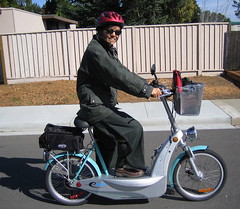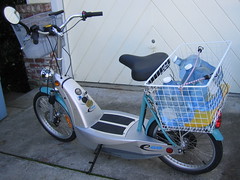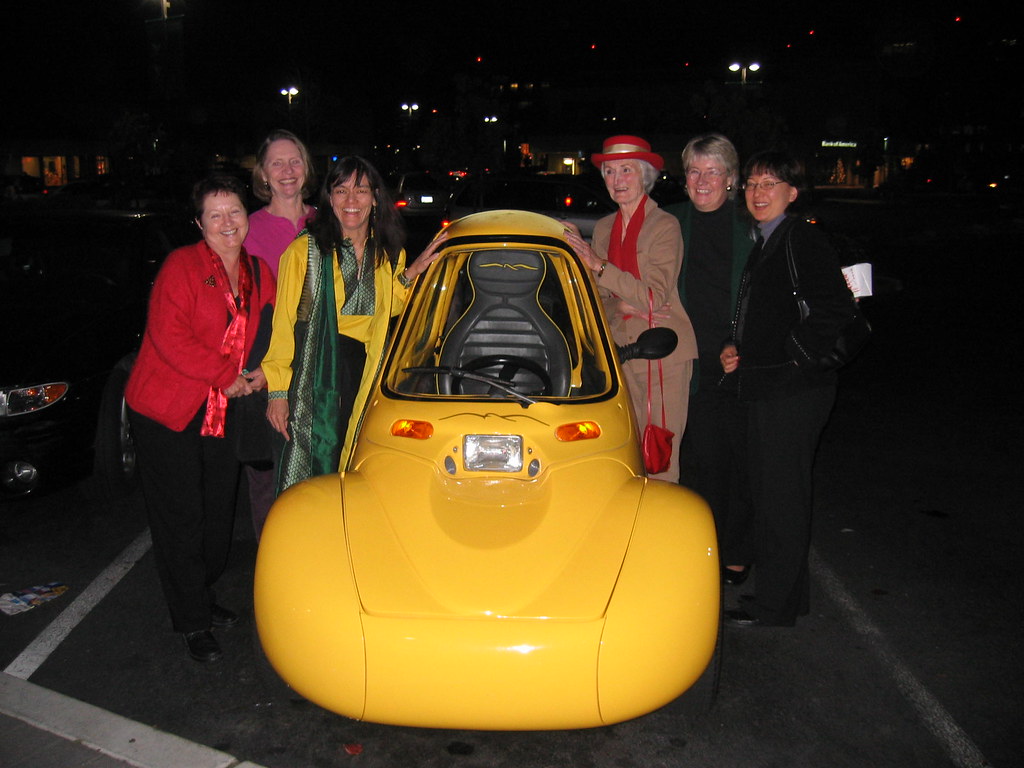The eGo Cycle
With the Sparrow out of commission I felt I had to have another EV type transport. With peak oil looming on the horizon, it seemed prudent rather than frivolous to have another EV in the house. Even when the Sparrow returned, I knew there would still be a place for the eGo cycle on the days when Catherine took the Sparrow to work.
After researching the various bike/motor hybrids, I decided to dispense with pedals and settle for just the electric motor, since it was half the price. Other EV members of my chapter had recommended the eGo cycle for its potential for modification to increase speed and range, so I ordered one from the Real Goods/Gaim catalog on sale for $999. The company is in Rhode Island, but, now, the scooter is made in Taiwan.
It came delivered by air frieght in about four weeks and I assembled it that afternoon which meant slipping the fully assembled fork into the body, with the locknuts in the right order and making sure all the brake cables were untangled. My biggest concern was that it make it up the various hills around my house without burning out the motor. The manual warned about going up hills that took longer than 30 seconds to climb. Hills were why I wanted the eGo Cycle because I'm not a big hill climber on my bicycle. The eGo cycle's primary purpose would be to get me to my mother's house.
(It is interesting to note that new housing developments have unreasonably steep streets simply because modern vehicles can climb those hills easily whereas in the pre-50's neighborhood, more care was taken to grade streets up hills so that other types of traffic could make it. This means that these hills are basically off limits to bicycle traffic. What about San Francisco one might well ask? Same thing, but they had cable cars in the older parts of town and then developed the rest later. Also the steep streets are shorter in San Francisco except in the Twin Peaks area.)
Luckily I have yet to climb a hill the eGo cycle couldn't make and I've been up ones that took much longer than 30 seconds to climb. There was a break-in period of four hours when I took care to stay mostly on the flats, but after that it was good to go. Soon it became my grocery runner. I put a good size deep basket on the front and had my bicycle bag on the rack in back, but then I found a really big basket I could zip tie to the rack. I've been able to carry a full size bush in it (for transplanting to my mother's garden) and I can also fit things in front of my feet right on the deck, securing it with a long bungee cord around the control post, flowers for instance or another plant.
The scooter charges up in about four hours and takes less than a kilowatt of juice, about a fifth of what the Sparrow needs. It has a range of 20 miles, but I can't imagine sitting on it for that long. The range is considerably shortened by hills, so I have used the "go far" mode to get home. In the "go far" mode, it's slower than riding a bicycle, so I nearly always have it in the "go fast" mode which gets it up to 23 mph, unless going up a hill, then it's more like 13-14 mph. Though not a head turner like the Sparrow, it gets some attention when people see it close up and realize it is electric.
After researching the various bike/motor hybrids, I decided to dispense with pedals and settle for just the electric motor, since it was half the price. Other EV members of my chapter had recommended the eGo cycle for its potential for modification to increase speed and range, so I ordered one from the Real Goods/Gaim catalog on sale for $999. The company is in Rhode Island, but, now, the scooter is made in Taiwan.
It came delivered by air frieght in about four weeks and I assembled it that afternoon which meant slipping the fully assembled fork into the body, with the locknuts in the right order and making sure all the brake cables were untangled. My biggest concern was that it make it up the various hills around my house without burning out the motor. The manual warned about going up hills that took longer than 30 seconds to climb. Hills were why I wanted the eGo Cycle because I'm not a big hill climber on my bicycle. The eGo cycle's primary purpose would be to get me to my mother's house.
(It is interesting to note that new housing developments have unreasonably steep streets simply because modern vehicles can climb those hills easily whereas in the pre-50's neighborhood, more care was taken to grade streets up hills so that other types of traffic could make it. This means that these hills are basically off limits to bicycle traffic. What about San Francisco one might well ask? Same thing, but they had cable cars in the older parts of town and then developed the rest later. Also the steep streets are shorter in San Francisco except in the Twin Peaks area.)
Luckily I have yet to climb a hill the eGo cycle couldn't make and I've been up ones that took much longer than 30 seconds to climb. There was a break-in period of four hours when I took care to stay mostly on the flats, but after that it was good to go. Soon it became my grocery runner. I put a good size deep basket on the front and had my bicycle bag on the rack in back, but then I found a really big basket I could zip tie to the rack. I've been able to carry a full size bush in it (for transplanting to my mother's garden) and I can also fit things in front of my feet right on the deck, securing it with a long bungee cord around the control post, flowers for instance or another plant.
The scooter charges up in about four hours and takes less than a kilowatt of juice, about a fifth of what the Sparrow needs. It has a range of 20 miles, but I can't imagine sitting on it for that long. The range is considerably shortened by hills, so I have used the "go far" mode to get home. In the "go far" mode, it's slower than riding a bicycle, so I nearly always have it in the "go fast" mode which gets it up to 23 mph, unless going up a hill, then it's more like 13-14 mph. Though not a head turner like the Sparrow, it gets some attention when people see it close up and realize it is electric.




1 Comments:
Ya its cool and i think these
are our future transport vehicles.
As the fossil fuels almost becoming
extinct, this type of vehicles are the
only way ahead..
Make website india
Post a Comment
<< Home